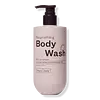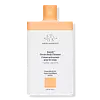What's inside
What's inside
 Key Ingredients
Key Ingredients

No key ingredients
 Benefits
Benefits

 Concerns
Concerns

 Ingredients Side-by-side
Ingredients Side-by-side

Water
Skin ConditioningCocamidopropyl Betaine
CleansingSodium Lauroyl Sarcosinate
CleansingGlycol Distearate
EmollientLaureth-4
EmulsifyingDecyl Glucoside
CleansingCocamine Oxide
CleansingAcrylates/C10-30 Alkyl Acrylate Crosspolymer
Emulsion StabilisingParfum
MaskingPotassium Sorbate
PreservativeAvena Sativa Straw Extract
Skin ConditioningPanthenol
Skin ConditioningTocopheryl Acetate
AntioxidantSqualane
EmollientPersea Gratissima Oil
Skin ConditioningPhenoxyethanol
PreservativeTriethanolamine
BufferingWater, Cocamidopropyl Betaine, Sodium Lauroyl Sarcosinate, Glycol Distearate, Laureth-4, Decyl Glucoside, Cocamine Oxide, Acrylates/C10-30 Alkyl Acrylate Crosspolymer, Parfum, Potassium Sorbate, Avena Sativa Straw Extract, Panthenol, Tocopheryl Acetate, Squalane, Persea Gratissima Oil, Phenoxyethanol, Triethanolamine
Water
Skin ConditioningSodium Laurylglucosides Hydroxypropylsulfonate
CleansingCoco-Glucoside
CleansingGlycerin
HumectantCocamidopropyl Betaine
CleansingSodium Methyl Cocoyl Taurate
CleansingSodium Chloride
MaskingSclerocarya Birrea Seed Oil
HumectantCoconut Alkanes
EmollientPassiflora Edulis Seed Oil
EmollientPlukenetia Volubilis Seed Oil
EmollientPrunus Amygdalus Dulcis Oil
Skin ConditioningCaprylic/Capric Triglyceride
MaskingCassia Hydroxypropyltrimonium Chloride
Carbomer
Emulsion StabilisingSodium PCA
HumectantPanthenol
Skin ConditioningGlycol Distearate
EmollientSodium Lactate
BufferingHelianthus Annuus Seed Oil
EmollientGlycine Soja Oil
EmollientPCA
HumectantAlanine
MaskingArginine
MaskingGlycine
BufferingHistidine
HumectantIsoleucine
Skin ConditioningPhenylalanine
MaskingProline
Skin ConditioningSerine
MaskingThreonine
Valine
MaskingCoco-Caprylate/Caprate
EmollientAspartic Acid
MaskingPrunus Amygdalus Dulcis Seed Extract
Skin ConditioningBenzoic Acid
MaskingPhenoxyethanol
PreservativeDehydroacetic Acid
PreservativeSodium Acetate
BufferingWater, Sodium Laurylglucosides Hydroxypropylsulfonate, Coco-Glucoside, Glycerin, Cocamidopropyl Betaine, Sodium Methyl Cocoyl Taurate, Sodium Chloride, Sclerocarya Birrea Seed Oil, Coconut Alkanes, Passiflora Edulis Seed Oil, Plukenetia Volubilis Seed Oil, Prunus Amygdalus Dulcis Oil, Caprylic/Capric Triglyceride, Cassia Hydroxypropyltrimonium Chloride, Carbomer, Sodium PCA, Panthenol, Glycol Distearate, Sodium Lactate, Helianthus Annuus Seed Oil, Glycine Soja Oil, PCA, Alanine, Arginine, Glycine, Histidine, Isoleucine, Phenylalanine, Proline, Serine, Threonine, Valine, Coco-Caprylate/Caprate, Aspartic Acid, Prunus Amygdalus Dulcis Seed Extract, Benzoic Acid, Phenoxyethanol, Dehydroacetic Acid, Sodium Acetate
 Reviews
Reviews

Ingredients Explained
These ingredients are found in both products.
Ingredients higher up in an ingredient list are typically present in a larger amount.
Cocamidopropyl Betaine is a fatty acid created by mixing similar compounds in coconut oil and dimethylaminopropylamine, a compound with two amino groups.
This ingredient is a surfactant and cleanser. It helps gather the dirt, pollutants, and other impurities in your skin to be washed away. It also helps thicken a product and make the texture more creamy.
Being created from coconut oil means Cocamidopropyl Betaine is hydrating for the skin.
While Cocamidopropyl Betaine was believed to be an allergen, a study from 2012 disproved this. It found two compounds in unpure Cocamidopropyl Betaine to be the irritants: aminoamide and 3-dimethylaminopropylamine. High-grade and pure Cocamidopropyl Betaine did not induce allergic reactions during this study.
Learn more about Cocamidopropyl BetaineGlycol Distearate serves as a pearlizing or opacifying agent in cosmetic products.
It's often included in cleansers and haircare products to give them a lustrous or shimmering appearance.
It is derived from stearic acid, a natural fatty acid commonly found in vegetable oils and animal fats.
Glycol Distearate isn't fungal acne safe.
Learn more about Glycol DistearatePanthenol is a common ingredient that helps hydrate and soothe the skin. It is found naturally in our skin and hair.
There are two forms of panthenol: D and L.
D-panthenol is also known as dexpanthenol. Most cosmetics use dexpanthenol or a mixture of D and L-panthenol.
Panthenol is famous due to its ability to go deeper into the skin's layers. Using this ingredient has numerous pros (and no cons):
Like hyaluronic acid, panthenol is a humectant. Humectants are able to bind and hold large amounts of water to keep skin hydrated.
This ingredient works well for wound healing. It works by increasing tissue in the wound and helps close open wounds.
Once oxidized, panthenol converts to pantothenic acid. Panthothenic acid is found in all living cells.
This ingredient is also referred to as pro-vitamin B5.
Learn more about PanthenolPhenoxyethanol is a preservative that has germicide, antimicrobial, and aromatic properties. Studies show that phenoxyethanol can prevent microbial growth. By itself, it has a scent that is similar to that of a rose.
It's often used in formulations along with Caprylyl Glycol to preserve the shelf life of products.
Water. It's the most common cosmetic ingredient of all. You'll usually see it at the top of ingredient lists, meaning that it makes up the largest part of the product.
So why is it so popular? Water most often acts as a solvent - this means that it helps dissolve other ingredients into the formulation.
You'll also recognize water as that liquid we all need to stay alive. If you see this, drink a glass of water. Stay hydrated!
Learn more about Water